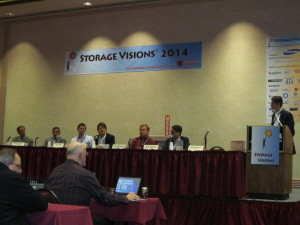Technology continues to advance rapidly. Making sense of it all can be a challenge. At the SNIA Ethernet Storage Forum, we focus on storage technologies and solutions enabled by and associated with Ethernet Networks. Last year, we modified the charters of our two Special Interest Groups (SIG) to address topics about file protocols and storage over Ethernet. The File Protocols SIG includes the prior focus on Network File System (NFS) related topics and adds discussions around Server Message Block (SMB / CIFS). We had our first webcast last November on the topic of SMB 3.0 and it was our best attended webcast ever. The Storage over Ethernet SIG focuses on general Ethernet storage topics as well as more information about technologies like FCoE, iSCSI, Data Center Bridging, and virtual networking for storage. I encourage you to check out other articles on these hot topics in this SNIAESF blog to hear from our member experts as well as guest posts from leading analysts.
2013 was a busy year and we are already kickin’ it in 2014. This should be an exciting year in IT. Data storage continues to be a hot sector especially in the areas of All-Flash and Hybrid arrays. This year, we will expect to see new standards coming out of the T11 committee for Fibre Channel and possibly FCoE as well as progress in high speed Ethernet networks. Lower cost network interconnects will facilitate adoption of high speed networks in the small to midsize business segment. And a new conversation around “Software Defined…” should push a lot of ink in trade rags and other news sources. Oh, and don’t forget about the “Internet of Things”, mobile solutions, and all things Cloud.
The ESF will be addressing the impact on Ethernet storage solutions from these hot technologies. Next month, on February 18th, experts from the ESF, along with industry analysts from Dell’Oro Group will speak to the benefits and best practices of deploying FCoE and iSCSI storage protocols. This presentation “Use Cases for iSCSI and Fibre Channel: Where Each Makes Sense” will be part of an upcoming BrightTalk Summit on Storage Networking. I encourage you to register for this session. Additionally, we will be publishing a couple of white papers on file-based storage and a review of FCoE and iSCSI in storage applications.
Finally, SNIA will be kicking off its first year of the new user conference, Data Storage Innovation Conference. This will be one of the few storage focused user conferences in the market and should be quite interesting.
We’re excited about our growing membership and our plans for 2014. Our goal is to advance application of innovative technologies and we encourage you to send us mail or comment below with topics that are of interest to you.
Here’s to an exciting 2014!
